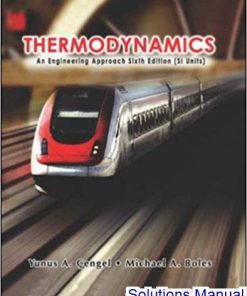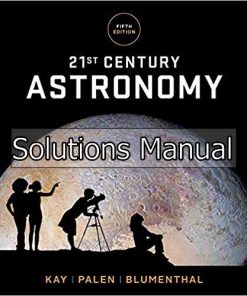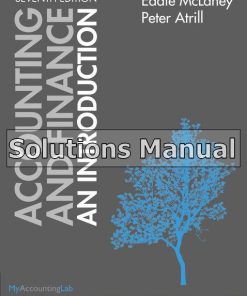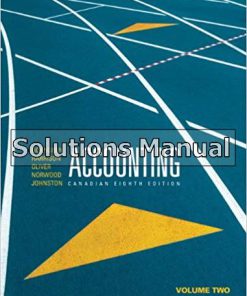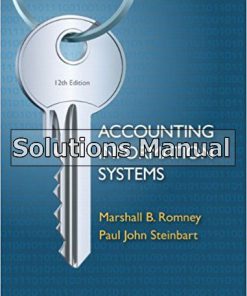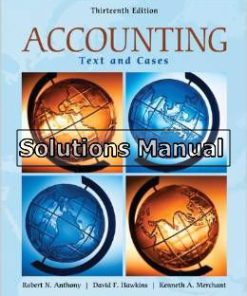Thermodynamics An Engineering Approach 7th Edition Cengel Solutions Manual
$26.50$50.00 (-47%)
Thermodynamics An Engineering Approach 7th Edition Cengel Solutions Manual.
You may also like
This is completed downloadable of Thermodynamics An Engineering Approach 7th Edition Cengel Solutions Manual

Product Details:
- ISBN-10 : 0071311114
- ISBN-13 : 978-0071311113
- Author:
Thermodynamics Seventh Edition covers the basic principles of thermodynamics while presenting a wealth of real-world engineering examples so students get a feel for how thermodynamics is applied in engineering practice. This text helps students develop an intuitive understanding of thermodynamics by emphasizing the physics and physical arguments. Cengel/Boles explore the various facets of thermodynamics through careful explanations of concepts and its use of numerous practical examples and figures, having students develop necessary skills to bridge the gap between knowledge and the confidence to properly apply knowledge. The media package for this text is extensive, giving users a large variety of supplemental resources to choose from. A Student Resources DVD is packaged with each new copy of the text and contains the popular Engineering Equation Solver (EES) software. McGraw-Hill’s new Connect is available to students and instructors. Connect is a powerful, web-based assignment management system that makes creating and grading assignments easy for instructors and learning convenient for students. It saves time and makes learning for students accessible anytime, anywhere. With Connect, instructors can easily manage assignments, grading, progress, and students receive instant feedback from assignments and practice problems.
Table of Content:
Chapter 1 INTRODUCTION AND BASIC CONCEPTS Application Areas of Thermodynamics 3 1-2 Importance of Dimensions and Units 3 Some SI and English Units 6 Dimensional Homogeneity 8 Unity Conversion Ratios 9 1?3 Systems and Control Volumes 10 1?4 Properties of a System 12 Continuum 12 1?5 Density and Specific Gravity 13 1?6 State and Equilibrium 14 The State Postulate 14 1-7 Processes and Cycles 15 The Steady-Flow Process 16 1-8 Temperature and the Zeroth Law of Thermodynamics 17 Temperature Scales 17 The International Temperature Scale of 1990 (ITS-90) 20 1-9 Pressure 21 Variation of Pressure with Depth 23 1-10 The Manometer 26 Other Pressure Measurement Devices 29 1-11 The Barometer and Atmospheric Pressure 29 1-12 Problem-Solving Technique 33 Step 1: Problem Statement 33 Step 2: Schematic 33 Step 3: Assumptions and Approximations 34 Step 4: Physical Laws 34 Step 5: Properties 34 Step 6: Calculations 34 Step 7: Reasoning, Verification, and Discussion 34 Engineering Software Packages 35 Engineering Equation Solver (EES) 36 A Remark on Significant Digits 38 Summary 39 References and Suggested Readings 39 Problems 40 Chapter 2 ENERGY, ENERGY TRANSFER, AND GENERAL ENERGY ANALYSIS | 51 2?1 Introduction 52 2?2 Forms of Energy 53 Some Physical Insight to Internal Energy 55 More on Nuclear Energy 56 Mechanical Energy 58 2?3 Energy Transfer by Heat 60 Historical Background on Heat 61 2?4 Energy Transfer by Work 62 Electrical Work 65 2?5 Mechanical Forms of Work 66 Shaft Work 66 Spring Work 67 Work Done on Elastic Solid Bars 67 Work Associated with the Stretching of a Liquid Film 68 Work Done to Raise or to Accelerate a Body 68 Nonmechanical Forms of Work 69 2?6 The First Law of Thermodynamics 70 Energy Balance 71 Energy Change of a System, Esystem 72 Mechanisms of Energy Transfer, Ein and Eout 73 2?7 Energy Conversion Efficiencies 78 Efficiencies of Mechanical and Electrical Devices 82 2?8 Energy and Environment 86 Ozone and Smog 87 Acid Rain 88 The Greenhouse Effect: Global Warming and Climate Change 89 Topic of Special Interest: Mechanisms of Heat Transfer 92 Summary 96 References and Suggested Readings 97 Problems 98 Chapter 3 PROPERTIES OF PURE SUBSTANCES | 111 3?1 Pure Substance 112 3?2 Phases of a Pure Substance 112 3?3 Phase-Change Processes of Pure Substances 113 Compressed Liquid and Saturated Liquid 114 Saturated Vapor and Superheated Vapor 114 Saturation Temperature and Saturation Pressure 115 Some Consequences of Tsat and Psat Dependence 117 3?4 Property Diagrams for Phase-Change Processes 118 1 The T-v Diagram 118 2 The P-v Diagram 120 Extending the Diagrams to Include the Solid Phase 121 3 The P-T Diagram 124 The P-v-T Surface 125 3?5 Property Tables 126 Enthalpy A Combination Property 126 1a Saturated Liquid and Saturated Vapor States 127 1b Saturated Liquid/Vapor Mixture 129 2 Superheated Vapor 132 3 Compressed Liquid 133 Reference State and Reference Values 135 3?6 The Ideal-Gas Equation of State 137 Is Water Vapor an Ideal Gas? 139 3?7 Compressibility Factor A Measure of Deviation from Ideal-Gas Behavior 139 3?8 Other Equations of State 144 Van der Waals Equation of State 144 Beattie-Bridgeman Equation of State 145 Benedict-Webb-Rubin Equation of State 145 Virial Equation of State 145 Topic of Special Interest: Vapor Pressure and Phase Equilibrium 149 Summary 153 References and Suggested Readings 154 Problems 154 Chapter 4 ENERGY ANALYSIS OF CLOSED SYSTEMS | 165 4?1 Moving Boundary Work 166 Polytropic Process 171 4?2 Energy Balance for Closed Systems 173 4?3 Specific Heats 178 4?4 Internal Energy, Enthalpy, and Specific Heats of Ideal Gases 180 Specific Heat Relations of Ideal Gases 182 4?5 Internal Energy, Enthalpy, and Specific Heats of Solids and Liquids 189 Internal Energy Changes 189 Enthalpy Changes 189 Topic of Special Interest: Thermodynamic Aspects of Biological Systems 193 Summary 200 References and Suggested Readings 201 Problems 201 Chapter 5 MASS AND ENERGY ANALYSIS OF CONTROL VOLUMES | 219 5?1 Conservation of Mass 220 Mass and Volume Flow Rates 220 Conservation of Mass Principle 222 Mass Balance for Steady-Flow Processes 223 Special Case: Incompressible Flow 224 5?2 Flow Work and the Energy of a Flowing Fluid 226 Total Energy of a Flowing Fluid 227 Energy Transport by Mass 228 5?3 Energy Analysis of Steady-Flow Systems 230 5?4 Some Steady-Flow Engineering Devices 233 1 Nozzles and Diffusers 233 2 Turbines and Compressors 236 3 Throttling Valves 239 4a Mixing Chambers 240 4b Heat Exchangers 242 5 Pipe and Duct Flow 244 5?5 Energy Analysis of Unsteady-Flow Processes 246 Topic of Special Interest: General Energy Equation 252 Summary 255 References and Suggested Readings 256 Problems 256 Chapter 6 THE SECOND LAW OF THERMODYNAMICS | 279 6?1 Introduction to the Second Law 280 6?2 Thermal Energy Reservoirs 281 6?3 Heat Engines 282 Thermal Efficiency 283 Can We Save Qout? 285 The Second Law of Thermodynamics: Kelvin--Planck Statement 287 6?4 Refrigerators and Heat Pumps 287 Coefficient of Performance 288 Heat Pumps 289 The Second Law of Thermodynamics: Clausius Statement 292 Equivalence of the Two Statements 292 6?5 Perpetual-Motion Machines 293 6?6 Reversible and Irreversible Processes 296 Irreversibilities 297 Internally and Externally Reversible Processes 298 6?7 The Carnot Cycle 299 The Reversed Carnot Cycle 301 6?8 The Carnot Principles 301 6?9 The Thermodynamic Temperature Scale 303 6?10 The Carnot Heat Engine 305 The Quality of Energy 307 Quantity versus Quality in Daily Life 308 6?11 The Carnot Refrigerator and Heat Pump 309 Topic of Special Interest: Household Refrigerators 311 Summary 315 References and Suggested Readings 316 Problems 316 Chapter 7 ENTROPY | 331 7?1 Entropy 331 A Special Case: Internally Reversible Isothermal Heat Transfer Processes 334 7?2 The Increase of Entropy Principle 335 Some Remarks about Entropy 337 7?3 Entropy Change of Pure Substances 339 7?4 Isentropic Processes 343 7?5 Property Diagrams Involving Entropy 344 7?6 What Is Entropy? 346 Entropy and Entropy Generation in Daily Life 348 7?7 The T ds Relations 350 7?8 Entropy Change of Liquids and Solids 351 7?9 The Entropy Change of Ideal Gases 354 Constant Specific Heats (Approximate Analysis) 355 Variable Specific Heats (Exact Analysis) 356 Isentropic Processes of Ideal Gases 358 Constant Specific Heats (Approximate Analysis) 358 Variable Specific Heats (Exact Analysis) 359 Relative Pressure and Relative Specific Volume 359 7?10 Reversible Steady-Flow Work 362 Proof that Steady-Flow Devices Deliver the Most and Consume the Least Work when the Process Is Reversible 365 7?11 Minimizing the Compressor Work 366 Multistage Compression with Intercooling 367 7?12 Isentropic Efficiencies of Steady-Flow Devices 370 Isentropic Efficiency of Turbines 371 Isentropic Efficiencies of Compressors and Pumps 373 Isentropic Efficiency of Nozzles 375 7?13 Entropy Balance 377 Entropy Change of a System, System 378 Mechanisms of Entropy Transfer, Sin and Sout 378 1 Heat Transfer 378 2 Mass Flow 379 Entropy Generation, Sgen 380 Closed Systems 381 Control Volumes 381 Entropy Generation Associated with a Heat Transfer Process 389 Topic of Special Interest: Reducing the Cost of Compressed Air 391 Summary 400 References and Suggested Readings 401 Problems 402 Chapter 8 EXERGY: A MEASURE OF WORK POTENTIAL | 423 8?1 Exergy: Work Potential of Energy 424 Exergy (Work Potential) Associated with Kinetic and Potential Energy 425 8?2 Reversible Work and Irreversibility 427 8?3 Second-Law Efficiency, nII 432 8?4 Exergy Change of a System 434 Exergy of a Fixed Mass: Nonflow (or Closed System) Exergy 435 Exergy of a Flow Stream: Flow (or Stream) Exergy 437 8?5 Exergy Transfer by Heat, Work, and Mass 440 Exergy by Heat Transfer, Q 440 Exergy Transfer by Work, W 442 Exergy Transfer by Mass, m 442 8?6 The Decrease of Exergy Principle and Exergy Destruction 443 Exergy Destruction 444 8?7 Exergy Balance: Closed Systems 444 8?8 Exergy Balance: Control Volumes 457 Exergy Balance for Steady-Flow Systems 458 Reversible Work, W rev 459 Second-Law Efficiency of Steady-Flow Devices, nII 459 Topic of Special Interest: Second-Law Aspects of Daily Life 465 Summary 469 References and Suggested Readings 470 Problems 470 Chapter 9 GAS POWER CYCLES | 487 9?1 Basic Considerations in the Analysis of Power Cycles 488 9?2 The Carnot Cycle and Its Value in Engineering 490 9?3 Air-Standard Assumptions 492 9?4 An Overview of Reciprocating Engines 493 9?5 Otto Cycle: The Ideal Cycle for Spark-Ignition Engines 494 9?6 Diesel Cycle: The Ideal Cycle for Compression-Ignition Engines 500 9?7 Stirling and Ericsson Cycles 503 9?8 Brayton Cycle: The Ideal Cycle for Gas-Turbine Engines 507 Development of Gas Turbines 510 Deviation of Actual Gas-Turbine Cycles from Idealized Ones 513 9?9 The Brayton Cycle with Regeneration 515 9?10 The Brayton Cycle with Intercooling, Reheating, and Regeneration 517 9?11 Ideal Jet-Propulsion Cycles 521 Modifications to Turbojet Engines 525 9?12 Second-Law Analysis of Gas Power Cycles 527 Topic of Special Interest: Saving Fuel and Money by Driving Sensibly 530 Summary 537 References and Suggested Readings 538 Problems 539 Chapter 10 VAPOR AND COMBINED POWER CYCLES | 551 10?1 The Carnot Vapor Cycle 552 10?2 Rankine Cycle: The Ideal Cycle for Vapor Power Cycles 553 Energy Analysis of the Ideal Rankine Cycle 554 10?3 Deviation of Actual Vapor Power Cycles from Idealized Ones 557 10?4 How Can We Increase the Efficiency of the Rankine Cycle? 560 Lowering the Condenser Pressure (Lowers Tlow,avg) 560 Superheating the Steam to High Temperatures (Increases Thigh,avg) 561 Increasing the Boiler Pressure (Increases Thigh,avg) 561 10?5 The Ideal Reheat Rankine Cycle 564 10?6 The Ideal Regenerative Rankine Cycle 568 Open Feedwater Heaters 568 Closed Feedwater Heaters 570 10?7 Second-Law Analysis of Vapor Power Cycles 576 10?8 Cogeneration 578 10?9 Combined Gas/Vapor Power Cycles 583 Topic of Special Interest: Binary Vapor Cycles 586 Summary 589 References and Suggested Readings 589 Problems 590 Chapter 11 REFRIGERATION CYCLES | 607 11?1 Refrigerators and Heat Pumps 608 11?2 The Reversed Carnot Cycle 609 11?3 The Ideal Vapor-Compression Refrigeration Cycle 610 11?4 Actual Vapor-Compression Refrigeration Cycle 614 11?5 Selecting the Right Refrigerant 616 11?6 Heat Pump Systems 618 11?7 Innovative Vapor-Compression Refrigeration Systems 620 Cascade Refrigeration Systems 620 Multistage Compression Refrigeration Systems 623 Multipurpose Refrigeration Systems with a Single Compressor 625 Liquefaction of Gases 626 11?8 Gas Refrigeration Cycles 628 11?9 Absorption Refrigeration Systems 631 Topic of Special Interest: Thermoelectric Power Generation and Refrigeration Systems 634 Summary 636 References and Suggested Readings 637 Problems 637 Chapter 12 THERMODYNAMIC PROPERTY RELATIONS | 651 12?1 A Little Math--Partial Derivatives and Associated Relations 652 Partial Differentials 653 Partial Differential Relations 655 12?2 The Maxwell Relations 656 12?3 The Clapeyron Equation 658 12?4 General Relations for du, dh, ds, cv, and cp 661 Internal Energy Changes 661 Enthalpy Changes 662 Entropy Changes 663 Specific Heats cv and cp 664 12?5 The Joule-Thomson Coefficient 668 12?6 The h, u, and s of Real Gases 669 Enthalpy Changes of Real Gases 670 Internal Energy Changes of Real Gases 671 Entropy Changes of Real Gases 671 Summary 674 References and Suggested Readings 675 Problems 675 Chapter 13 GAS MIXTURES | 681 13?1 Composition of a Gas Mixture: Mass and Mole Fractions 682 13?2 P-v-T Behavior of Gas Mixtures: Ideal and Real Gases 684 Ideal-Gas Mixtures 685 Real-Gas Mixtures 685 13?3 Properties of Gas Mixtures: Ideal and Real Gases 689 Ideal-Gas Mixtures 690 Real-Gas Mixtures 693 Topic of Special Interest: Chemical Potential and the Separation Work of Mixtures 697 Summary 708 References and Suggested Readings 709 Problems 709 Chapter 14 GAS?VAPOR MIXTURES AND AIR-CONDITIONING | 717 14?1 Dry and Atmospheric Air 718 14?2 Specific and Relative Humidity of Air 719 14?3 Dew-Point Temperature 721 14?4 Adiabatic Saturation and Wet-Bulb Temperatures 723 14?5 The Psychrometric Chart 726 14?6 Human Comfort and Air-Conditioning 727 14?7 Air-Conditioning Processes 729 Simple Heating and Cooling (w = constant) 730 Heating with Humidification 731 Cooling with Dehumidification 732 Evaporative Cooling 734 Adiabatic Mixing of Airstreams 735 Wet Cooling Towers 737 Summary 739 References and Suggested Readings 741 Problems 741 Chapter 15 CHEMICAL REACTIONS | 751 15?1 Fuels and Combustion 752 15?2 Theoretical and Actual Combustion Processes 756 15?3 Enthalpy of Formation and Enthalpy of Combustion 762 15?4 First-Law Analysis of Reacting Systems 765 Steady-Flow Systems 765 Closed Systems 767 15?5 Adiabatic Flame Temperature 770 15?6 Entropy Change of Reacting Systems 773 15?7 Second-Law Analysis of Reacting Systems 775 Topic of Special Interest: Fuel Cells 780 Summary 782 References and Suggested Readings 783 Problems 783 Chapter 16 CHEMICAL AND PHASE EQUILIBRIUM | 793 16?1 Criterion for Chemical Equilibrium 794 16?2 The Equilibrium Constant for Ideal-Gas Mixtures 796 16?3 Some Remarks about the KP of Ideal-Gas Mixtures 799 16?4 Chemical Equilibrium for Simultaneous Reactions 804 16?5 Variation of KP with Temperature 806 16?6 Phase Equilibrium 808 Phase Equilibrium for a Single-Component System 808 The Phase Rule 809 Phase Equilibrium for a Multicomponent System 810 Summary 815 References and Suggested Readings 816 Problems 817 Chapter 17 COMPRESSIBLE FLOW | 823 17?1 Stagnation Properties 824 17?2 Speed of Sound and Mach Number 827 17?3 One-Dimensional Isentropic Flow 829 Variation of Fluid Velocity with Flow Area 832 Property Relations for Isentropic Flow of Ideal Gases 834 17?4 Isentropic Flow through Nozzles 836 Converging Nozzles 836 Converging?Diverging Nozzles 841 17?5 Shock Waves and Expansion Waves 845 Normal Shocks 845 Oblique Shocks 852 Prandtl?Meyer Expansion Waves 856 17?6 Duct Flow with Heat Transfer and Negligible Friction (Rayleigh Flow) 860 Property Relations for Rayleigh Flow 866 Choked Rayleigh Flow 867 17?7 Steam Nozzles 869 Summary 872 References and Suggested Readings 873 Problems 874 Appendix 1 PROPERTY TABLES AND CHARTS (SI UNITS) | 883 Table A?1 Molar mass, gas constant, and critical-point properties 884 Table A?2 Ideal-gas specific heats of various common gases 885 Table A?3 Properties of common liquids, solids, and foods 888 Table A?4 Saturated water--Temperature table 890 Table A?5 Saturated water--Pressure table 892 Table A?6 Superheated water 894 Table A?7 Compressed liquid water 898 Table A?8 Saturated ice--water vapor 899 Figure A?9 T-s diagram for water 900 Figure A?10 Mollier diagram for water 901 Table A?11 Saturated refrigerant-134a?Temperature table 902 Table A?12 Saturated refrigerant-134a?Pressure table 904 Table A?13 Superheated refrigerant-134a 905 Figure A?14 P-h diagram for refrigerant-134a 907 Figure A?15 Nelson/Obert generalized compressibility chart 908 Table A?16 Properties of the atmosphere at high altitude 909 Table A?17 Ideal-gas properties of air 910 Table A?18 Ideal-gas properties of nitrogen, N2 912 Table A?19 Ideal-gas properties of oxygen, O2 914 Table A?20 Ideal-gas properties of carbon dioxide, CO2 916 Table A?21 Ideal-gas properties of carbon monoxide, CO 918 Table A?22 Ideal-gas properties of hydrogen, H2 920 Table A?23 Ideal-gas properties of water vapor, H2O 921 Table A?24 Ideal-gas properties of monatomic oxygen, O 923 Table A?25 Ideal-gas properties of hydroxyl, OH 923 Table A?26 Enthalpy of formation, Gibbs function of formation, and absolute entropy at 25?C, 1 atm 924 Table A?27 Properties of some common fuels and hydrocarbons 925 Table A?28 Natural logarithms of the equilibrium constant Kp 926 Figure A?29 Generalized enthalpy departure chart 927 Figure A?30 Generalized entropy departure chart 928 Figure A?31 Psychrometric chart at 1 atm total pressure 929 Table A?32 One-dimensional isentropic compressible-flow functions for an ideal gas with k = 1.4 930 Table A?33 One-dimensional normal-shock functions for an ideal gas with k =1.4 931 Table A?34 Rayleigh flow functions for an ideal gas with k = 1.4 932 Appendix 2 PROPERTY TABLES AND CHARTS (ENGLISH UNITS) | 933 Table A?1E Molar mass, gas constant, and critical-point properties 934 Table A?2E Ideal-gas specific heats of various common gases 935 Table A?3E Properties of common liquids, solids, and foods 938 Table A?4E Saturated water/Temperature table 940 Table A?5E Saturated water/Pressure table 942 Table A?6E Superheated water 944 Table A?7E Compressed liquid water 948 Table A?8E Saturated ice/water vapor 949 Figure A?9E T-s diagram for water 950 Figure A?10E Mollier diagram for water 951 Table A?11E Saturated refrigerant-134a?Temperature table 952 Table A?12E Saturated refrigerant-134a?Pressure table 953 Table A?13E Superheated refrigerant-134a 954 Figure A?14E P-h diagram for refrigerant-134a 956 Table A?16E Properties of the atmosphere at high altitude 957 Table A?17E Ideal-gas properties of air 958 Table A?18E Ideal-gas properties of nitrogen, N2 960 Table A?19E Ideal-gas properties of oxygen, O2 962 Table A?20E Ideal-gas properties of carbon dioxide, CO2 964 Table A?21E Ideal-gas properties of carbon monoxide, CO 966 Table A?22E Ideal-gas properties of hydrogen, H2 968 Table A?23E Ideal-gas properties of water vapor, H2O 969 Table A?26E Enthalpy of formation, Gibbs function of formation, and absolute entropy at 77?F, 1 atm 971 Table A?27E Properties of some common fuels and hydrocarbons 972 Figure A?31E Psycrometric chart at 1 atm total pressure 973 Index 975
People Also Search:
thermodynamics an engineering approach cengel
thermodynamics an engineering approach 7th edition cengel
thermodynamics an engineering approach 7th edition
thermodynamics an engineering approach 7th edition download scribd
thermodynamics an engineering approach 7th edition solution manual download pdf






